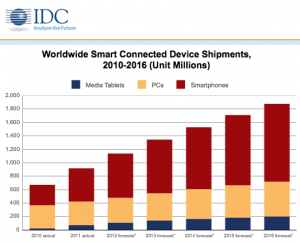This has been a quite a week for my family. We sold our house of 18 years and will be moving into the heart of the city of Toronto in the next two months. As a “Baby Boomer” this is a downsizing exercise and an opportunity for renewal. It is also giving us the ability to reduce our carbon footprint as we will eventually rid ourselves of our second car and move into less space to sustain our family. I will miss my perennial and shrub garden most of all but will become an expert on terrace gardening if given the time. I call this phase in our lives a metamorphosis, something that I think all of us on the planet will have to undergo by the end of the 21st century so that we can sustain our presence here on Earth.
In this week of personal upheaval what were the headlines that caught my eye?
- We Don’t Own Our Own DNA – What’s With That?
- 2012 the Year We Shipped 1 Billion Computing Devices
- Re-engineered Immune Cells Destroy Blood Cancer
- China May See Skyscrapers Fall
- New Company Proposes De-Extinction Business
How Can I Not Own My DNA?
Interesting question but apparently companies have filed more than 40,000 patents related to the human genome. In a published report on March 25 authored by Dr. Christopher Mason of Weill Cornell Medical College, and Dr. Jeffrey Rosenfeld of the University of Medicine & Dentistry of New Jersey, they reported that the entire human genome has been patented by for-profit companies. Of these DNA patents, 41% cover long sequences and whole genes.
The U.S. Supreme Court will be reviewing genomic patents in an upcoming hearing on April 15 related to ovarian and breast cancer gene discoveries. If the Court upholds the company patents it will mean you and I no longer own our own DNA and that any business that finds a useful application from genetic research will have more rights than we do. The implication of such patents will be profound for doctors and patients who are fighting diseases. Imagine having to get permission from a company to do a medical test for a cancer that infringes on one of these patents? The cartoon by Cathy Wilcox says it all.
Connectivity Everywhere as 1 Billion Devices Shipped in 2012
According to IDC latest estimates for 2012, shipped PCs, laptops, tablets, and smartphones surpassed 1 billion units globally and estimates by 2017 predict that number to grow to 2.2 billion (see the chart below). This revolution in ubiquitous computing and communication is driving innovation right around the planet. And what is so interesting about the trend is the move to smaller high-powered devices like smartphones with significant growth in the Developing World. Who are the businesses delivering the technology for this incredible growth? Number one and two are Samsung and Apple.
Clinical Trials Using Modified T Cells Destroy Leukemia
Re-engineered immune cells to attack chronic lymphocytic leukemia (seen in the image below) are proving to be therapeutically effective in destroying cancer cells according to a five-patient clinical trail reported in the journal Science Translational Medicine.
What’s involved? T cells are extracted, genetically modified and then re-inserted into a patient. The engineered modification tricks the T cell to identify a protein and receptor found in the cancer cells. So far all patients in the study experienced rapid clearing of the cancerous tumors. Doctors believe that this approach is very promising for chronic leukemia but still aren’t certain it will be as effective on acute lymphoblastic leukemia. The next step is to widen the clinical trials to more cancer centres.
Will Fast Growing China Witness the Collapse of Some of its Tallest Buildings?
According to a report in Wired in the last week there is a growing concern that the concrete being used in Chinese construction may prove to be the undoing of a number of buildings in major cities throughout the country. The culprit can be found in the sand used to mix concrete.
The recipe for concrete, a Roman invention going back over 2,000 years, is straightforward. You take cement, aggregate (sand, gravel and crushed stone) and water and mix them all together. The proportions are critical as is the quality of the aggregate. And the latter is what is in question.
Inspections by state officials are finding unprocessed sea sand in a number of buildings and untreated sea sand in concrete can lead to a building becoming dangerously unsafe within a couple of decades. When you consider that China plans to be topping off a new skyscraper every five days between now and through 2014 you can imagine the potential danger that lurks in the near future for those who occupy these buildings.
One of the new skyscrapers, the Ping An Finance Center in Shenzhen has had construction halted because testing has revealed sub-standard sea sand concrete has been used. The Ping An building (seen below in architectural drawing) was to top out at 660 meters, the second tallest building in the world.
Is There Money to be Made Bringing Extinct Animals Back to Life?
De-extinction is a new term, and a new start up company named Ark Corporation is out to make the term part of everyday conversation.
In a video posted on YouTube entitled Are We Playing God? various talking heads discourse on the subject.
The company has been co-founded by Robert Lanza and George Church, both experts on DNA and stem cells. The de-extinction, that is, the idea of reviving extinct species, could bring back the Woolly Mammoth, or the Passenger Pigeon (seen below). The key to doing this is to harvest DNA from well-preserved specimens that could then be cultured and implanted in a surrogate species to incubate and birth. The technology is very similar to cloning.
But why would we do this? The founders of Ark see enormous downstream practical applicability to advances in cell biology and genome engineering. Lanza has stated that he hopes to not only revive extinct species but improve breeding of livestock, or extend the lifespan of our pets.
A Postscript
If you want to receive 21st Century Tech blog postings in your inbox remember you can subscribe on the blog site home page. As always comments, questions and ideas for postings are welcome. If you come across a technology you feel should be part of this conversation please let me know by writing to info@21stcentech.com. Now back to packing and preparing for garage sales.
– Len Rosen





















